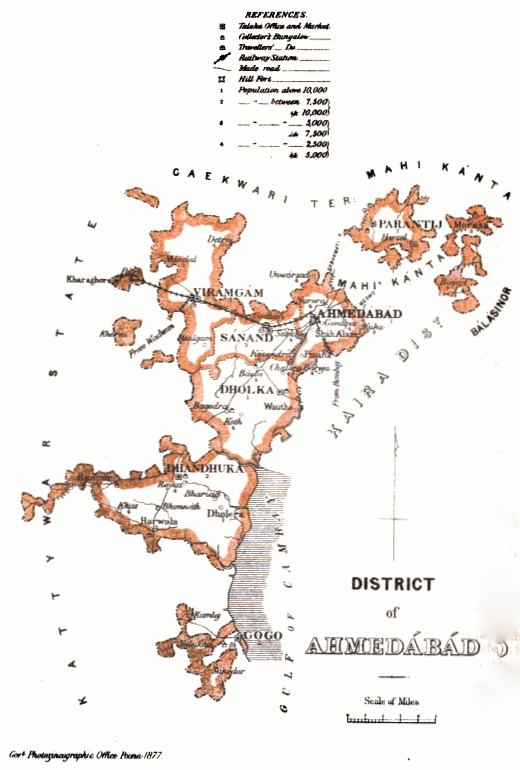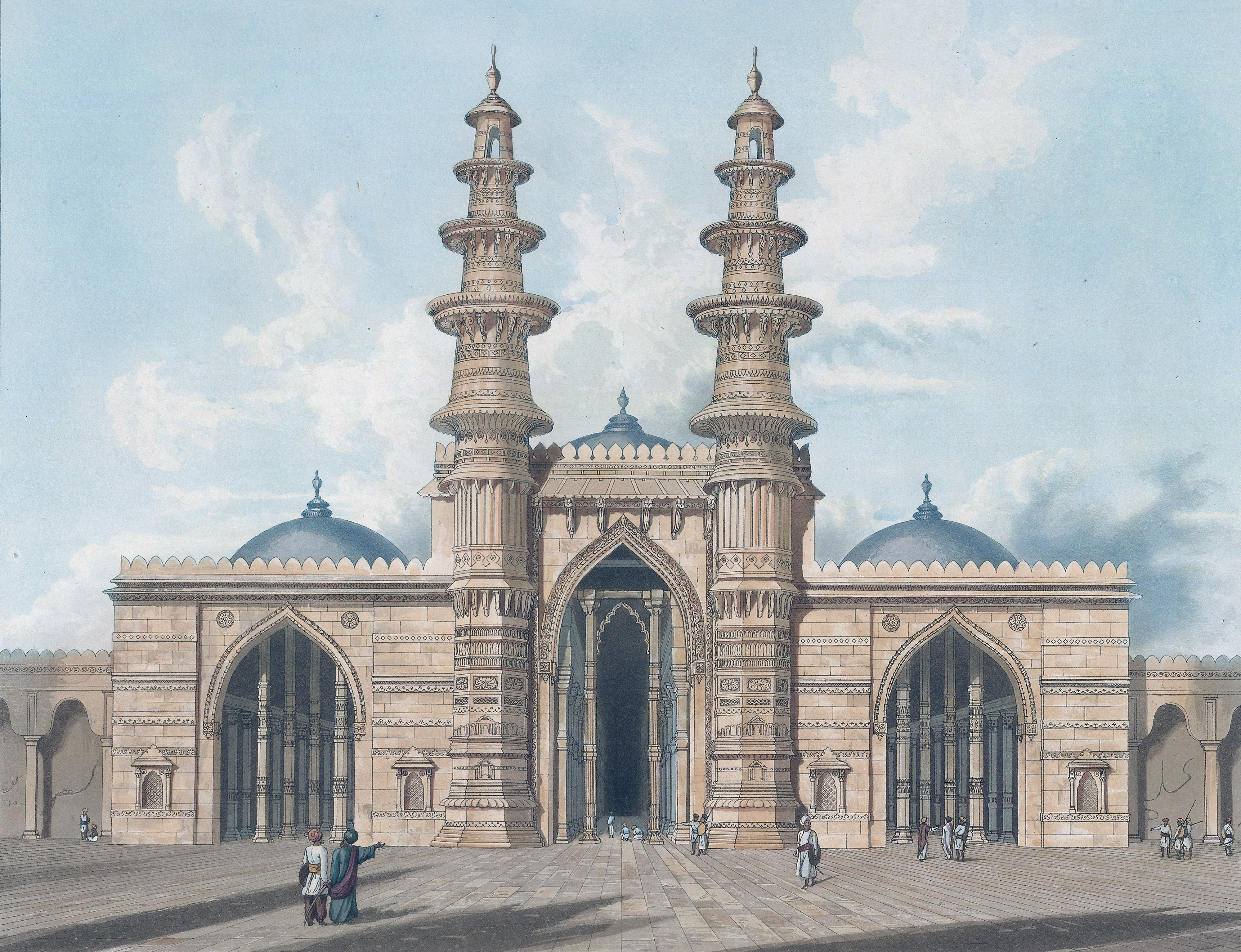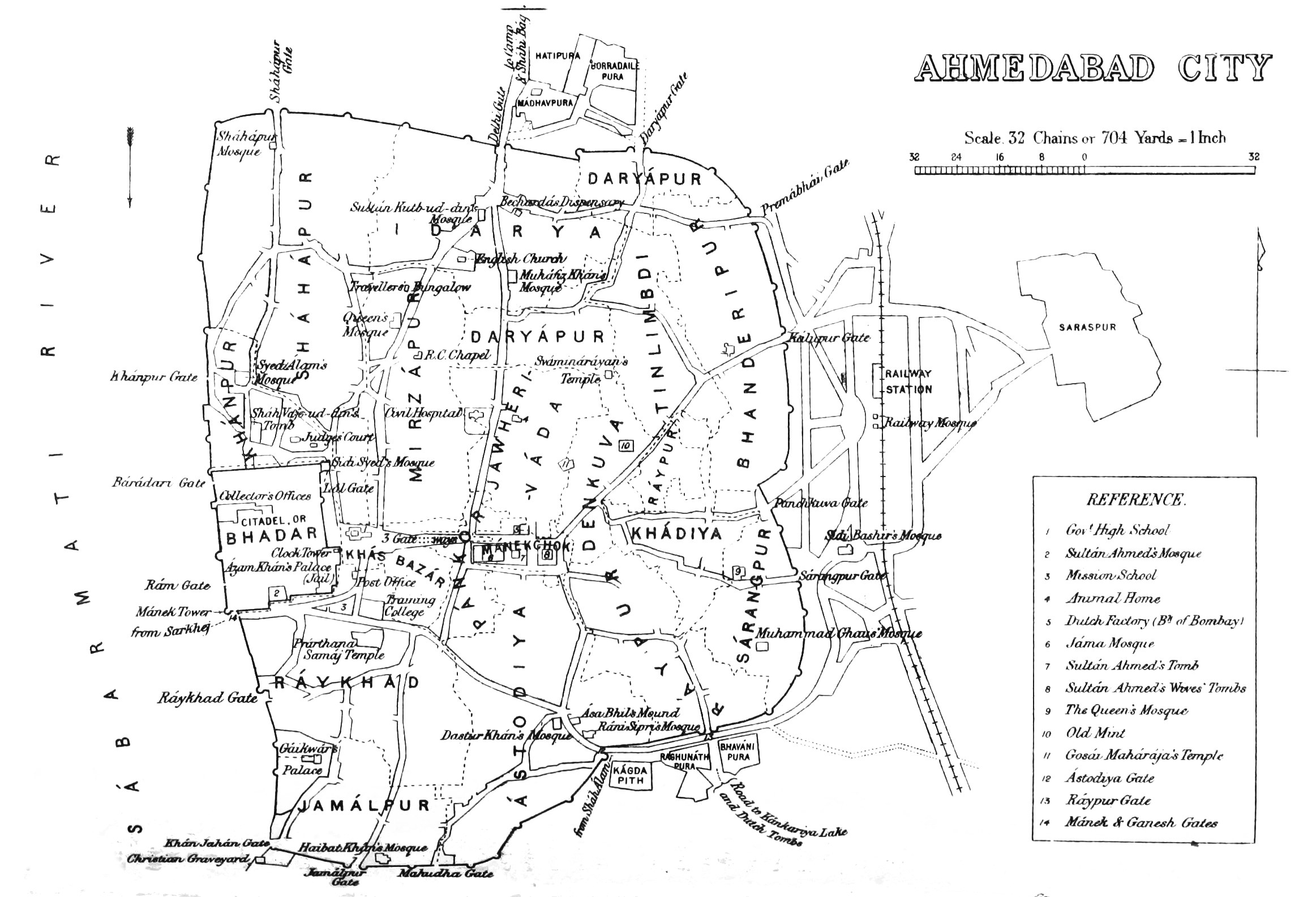|
Old Ahmedabad
The Historic City of Ahmadabad or Old Ahmedabad, the walled city of Ahmedabad in India, was founded by Ahmad Shah I of the Gujarat Sultanate in 1411. It remained the capital of the state of Gujarat for six centuries and later became the important political and commercial centre of Gujarat. Today, despite having become crowded and dilapidated, it still serves as the symbolic heart of metropolitan Ahmedabad. It was inscribed as the World Heritage City by UNESCO in July 2017. History The earliest settlements were situated south of the current old city and on the bank of Sabarmati river. It was known as Ashaval or Ashapalli. In the 11th century, Karna of the Chaulukya dynasty made the town his capital and named it Karnavati (Karna's town), Shrinagar (prosperous city), and Rajnagar (king's town). Ahmed Shah I laid the foundation of Bhadra Fort starting from Manek Burj, the first bastion of the city in 1411 which was completed in 1413. He also established the first square of the ... [...More Info...] [...Related Items...] OR: [Wikipedia] [Google] [Baidu] |
Ahmedabad District
{{Infobox settlement , name = Ahmedabad District , native_name = , native_name_lang = , settlement_type = District of Gujarat , image_skyline = Delhi Darwaja 1.jpg , imagesize = , HDI {{nobold, (2018) , blank_info_sec2 = {{increase 0.783{{cite web , title=Sub-national HDI – Area Database = 778(high) , image_alt = , image_caption = Delhi Darwaza, one of the gates to the old city , image_flag = , flag_alt = , image_seal = , seal_alt = , image_shield = , shield_alt = , nickname = Ahm , motto = save water drink beer , image_map = Ahmedabad in Gujarat (India).svg , map_alt = , ... [...More Info...] [...Related Items...] OR: [Wikipedia] [Google] [Baidu] |
Johan Albrecht De Mandelslo
Johan Albrecht de Mandelslo (1616–1644) was a seventeenth-century German adventurer, who wrote about his travels through Iran (Persia) and India. Born at Schönberg in Mecklenburg, Germany.Adam Olearius, ''The Voyages and Travels of the Ambassadors from the Duke of Holstein … Whereto are Added the Travels of J. Albert de Mandelslo … into the East-Indies'', tr. John Davies (London, Dring and Starkey, 1642) After traveling to Isfahan with a diplomatic mission, he separated from the party and made his way to India, where he made interesting observations on the Mughal Empire, then ruled by Shah Jahan. In 1638, Mandelslo visited the ruins at Persepolis in Persia; his name and the year can be found inscribed in the Gate of All Nations at the entrance to the site. Arriving at the port of Surat in April 1638, he moved on to Ahmedabad and Agra. While his observations of life in the capital are useful, he apparently heard nothing about the Taj Mahal, then in its sixth year of constr ... [...More Info...] [...Related Items...] OR: [Wikipedia] [Google] [Baidu] |
Islam
Islam (; ar, ۘالِإسلَام, , ) is an Abrahamic religions, Abrahamic Monotheism#Islam, monotheistic religion centred primarily around the Quran, a religious text considered by Muslims to be the direct word of God in Islam, God (or ''Allah'') as it was revealed to Muhammad, the Muhammad in Islam, main and final Islamic prophet.Peters, F. E. 2009. "Allāh." In , edited by J. L. Esposito. Oxford: Oxford University Press. . (See alsoquick reference) "[T]he Muslims' understanding of Allāh is based...on the Qurʿān's public witness. Allāh is Unique, the Creator, Sovereign, and Judge of mankind. It is Allāh who directs the universe through his direct action on nature and who has guided human history through his prophets, Abraham, with whom he made his covenant, Moses/Moosa, Jesus/Eesa, and Muḥammad, through all of whom he founded his chosen communities, the 'Peoples of the Book.'" It is the Major religious groups, world's second-largest religion behind Christianity, w ... [...More Info...] [...Related Items...] OR: [Wikipedia] [Google] [Baidu] |
Hinduism
Hinduism () is an Indian religion or '' dharma'', a religious and universal order or way of life by which followers abide. As a religion, it is the world's third-largest, with over 1.2–1.35 billion followers, or 15–16% of the global population, known as Hindus. The word ''Hindu'' is an exonym, and while Hinduism has been called the oldest religion in the world, many practitioners refer to their religion as '' Sanātana Dharma'' ( sa, सनातन धर्म, lit='the Eternal Dharma'), a modern usage, which refers to the idea that its origins lie beyond human history, as revealed in the Hindu texts. Another endonym is ''Vaidika dharma'', the dharma related to the Vedas. Hinduism is a diverse system of thought marked by a range of philosophies and shared concepts, rituals, cosmological systems, pilgrimage sites, and shared textual sources that discuss theology, metaphysics, mythology, Vedic yajna, yoga, agamic rituals, and temple building, among other to ... [...More Info...] [...Related Items...] OR: [Wikipedia] [Google] [Baidu] |
Haveli
A ''haveli'' is a traditional townhouse, mansion, manor house, in the Indian subcontinent, usually one with historical and architectural significance, and located in a town or city. The word ''haveli'' is derived from Arabic ''hawali'', meaning "partition" or "private space", popularised under the Mughal Empire, and was devoid of any architectural affiliations. Later, the word ''haveli'' came to be used as a generic term for various styles of regional mansions, manor houses, townhouse found in the Indian subcontinent. History Origin The term ''Haveli'' originates from Arabic word ''hawali'', meaning "partition" or "private space", term which was popularized under Mughal Empire. Early Havelis served Muslim rulers of the Indian Subcontinent and became an important architectural component of urban environments under the Mughals. Although Havelis originate from Indo-Islamic architecture, the existence of multistory homes and courtyards in the region is claimed as early as ... [...More Info...] [...Related Items...] OR: [Wikipedia] [Google] [Baidu] |
Pol (housing)
A ''pol'' (, pronounced as pole, gu, પોળ) in India is a housing cluster which comprises many families of a particular group, linked by caste, profession, or religion. Pols are typical of urban centres in Gujarat especially of Old Ahmedabad. Etymology The word pol is derived from the Sanskrit word ''pratoli'' meaning entrance to an enclosed area. Architecture and culture Pols were originally made as a protection measure when communal riots necessitated greater security probably dating from 1738 during Mughal-Maratha rule (1738–1753) in Ahmedabad. A typical pol would have only one or two entrances and also some secret entrances known only to people residing in a pol. Some pols contain old beautiful houses with internal courts having intricate wooden carved facades with columns and fresco work done around court walls or ceilings. Pol architecture is an interesting evolution in urban living space. Each pol was protected by a gateway closed at night as a safeguard against ... [...More Info...] [...Related Items...] OR: [Wikipedia] [Google] [Baidu] |
Pole 44
Pole may refer to: Astronomy *Celestial pole, the projection of the planet Earth's axis of rotation onto the celestial sphere; also applies to the axis of rotation of other planets *Pole star, a visible star that is approximately aligned with the Earth's axis of rotation *Orbital pole, the projection of the line perpendicular to planet Earth's orbit onto the celestial sphere; also applies to the orbit of other planets *Poles of astronomical bodies, concepts analogous to the Earth's geographic and magnetic poles on other planets and Solar System bodies Cylindrical objects A solid cylindrical object or column with its length greater than its diameter, for example: *Asherah pole, a sacred tree or pole that stood near Canaanite religious locations to honor the Ugaritic mother-goddess Asherah, consort of El *Barber's pole, advertising the barber shop *Ceremonial pole or festival pole symbolizes a variety of concepts in several different cultures *Fireman's pole, wooden pole or a metal ... [...More Info...] [...Related Items...] OR: [Wikipedia] [Google] [Baidu] |
Kalupur
Kalupur is a central area in Ahmedabad, the financial centre of Gujarat, India India, officially the Republic of India (Hindi: ), is a country in South Asia. It is the seventh-largest country by area, the second-most populous country, and the most populous democracy in the world. Bounded by the Indian Ocean on the so .... Geography It is located at . Location Kalupur is the central part of Ahmedabad city. Kalupur Bus Station runs buses to all major destinations in Ahmedabad city. The station is operated by Ahmedabad Municipal Transport Service (AMTS).http://www.india9.com/i9show/Kalupur-Bus-Station-82270.htm About Kalupur Bus Station Ahmedabad's main central railway station is also at Kalupur. Places of interest Shri Swaminarayan Temple, Ahmedabad is a delightful shrine situated at Kalupur. This is the first temple of the Shri Swaminarayan Sampraday. The temple enshrines images of Lord Narnarayandev, Lord Radhakrishna Dev, Lord Dharmadev-BhaktiMata, Lord Harikr ... [...More Info...] [...Related Items...] OR: [Wikipedia] [Google] [Baidu] |
Ahmedabad Mirror
''The Times of India'', also known by its abbreviation ''TOI'', is an Indian English-language daily newspaper and digital news media owned and managed by The Times Group. It is the third-largest newspaper in India by circulation and largest selling English-language daily in the world. It is the oldest English-language newspaper in India, and the second-oldest Indian newspaper still in circulation, with its first edition published in 1838. It is nicknamed as "The Old Lady of Bori Bunder", and is an Indian "newspaper of record". Near the beginning of the 20th century, Lord Curzon, the Viceroy of India, called ''TOI'' "the leading paper in Asia". In 1991, the BBC ranked ''TOI'' among the world's six best newspapers. It is owned and published by Bennett, Coleman & Co. Ltd. (B.C.C.L.), which is owned by the Sahu Jain family. In the Brand Trust Report India study 2019, ''TOI'' was rated as the most trusted English newspaper in India. Reuters rated ''TOI'' as India's most trusted m ... [...More Info...] [...Related Items...] OR: [Wikipedia] [Google] [Baidu] |
Jama Masjid, Ahmedabad
Jama Masjid (literally Friday Mosque), also known as Jumah Mosque or Jami' Masjid, is a mosque in Ahmedabad, and was built in 1424 during the reign of Ahmad Shah I. The inscription on the central mihrab commemorates the inauguration of the mosque on the 1st Safar A.H. 827 or January 4, 1424 A.D. by Sultan Ahmad Shah I. The mosque lies in the old walled city, and it is situated outside Bhadra Fort area. The old walled city is divided into separate quarters or pols, and the Jami' Masjid is found on the Gandhi Road. Along the south side of the road, the mosque is a short distance beyond the Teen Darwaza or Tripolia Gate. The Jama Masjid was the fifth mosque structure built during Ahmed Shah I's reign. The prior mosques had either been modest in size or were for private use. The Jama Masjid was the complete opposite of its predecessors in that it was a large, grandiose structure. The mosque complex has a large paved courtyard that can be entered from three different directions. Th ... [...More Info...] [...Related Items...] OR: [Wikipedia] [Google] [Baidu] |
Gates Of Ahmedabad
The ''Darwaja'' or Gates of Ahmedabad were built during different times starting from 1411 as the entrances to the walled city of Ahmedabad, Gujarat, India. These entrances to the city has a unique name and history. Pretty much the area surrounding these gates have adopted the name of the gate as the name of the locality. Each of the gate has beautiful carvings, calligraphy and some of them even balconies. History Ahmedabad was founded over the ancient settlement of Ashaval in 1411 by Ahmed Shah I of Gujarat Sultanate. He built the first citadel Bhadra Fort starting from Manek Burj, the first bastion of the city. The Bhadra Fort had eight gates excluding palace gates. When the city expanded, Ahmed Shah built the second fort which was later fortified by Mahmud Begada in 1486. The second fort had twelve major gates and other smaller gates. After arrival of railways, British built two more gates to facilitate the movement. Later the city walls were demolished leaving the gates ... [...More Info...] [...Related Items...] OR: [Wikipedia] [Google] [Baidu] |
Mahatma Gandhi
Mohandas Karamchand Gandhi (; ; 2 October 1869 – 30 January 1948), popularly known as Mahatma Gandhi, was an Indian lawyer, anti-colonial nationalist Quote: "... marks Gandhi as a hybrid cosmopolitan figure who transformed ... anti-colonial nationalist politics in the twentieth-century in ways that neither indigenous nor westernized Indian nationalists could." and political ethicist Quote: "Gandhi staked his reputation as an original political thinker on this specific issue. Hitherto, violence had been used in the name of political rights, such as in street riots, regicide, or armed revolutions. Gandhi believes there is a better way of securing political rights, that of nonviolence, and that this new way marks an advance in political ethics." who employed nonviolent resistance to lead the successful campaign for India's independence from British rule, and to later inspire movements for civil rights and freedom across the world. The honorific ''Mahātmā'' (Sanskrit ... [...More Info...] [...Related Items...] OR: [Wikipedia] [Google] [Baidu] |


.jpg)







